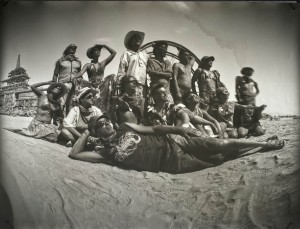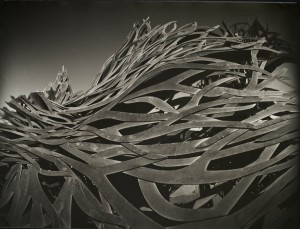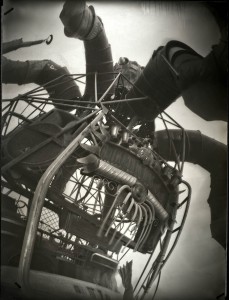 I met Nichon three years ago when she volunteered for Media Mecca. I almost didn’t let her in: she wanted to take pictures for Burning Man, and we don’t do that. She’s from the Netherlands, and I’d recently been burned by a lot of Northern European would-be volunteers. She’d just gotten a degree in fashion design, and if that doesn’t display poor judgment I don’t know what does.
I met Nichon three years ago when she volunteered for Media Mecca. I almost didn’t let her in: she wanted to take pictures for Burning Man, and we don’t do that. She’s from the Netherlands, and I’d recently been burned by a lot of Northern European would-be volunteers. She’d just gotten a degree in fashion design, and if that doesn’t display poor judgment I don’t know what does.
She made it on the team somehow, though – demonstrating great people skills and a gift for problem solving.
She stayed just long enough to accidentally quit.
Nichon noticed that Media Mecca lets a group of pinhole camera enthusiasts use some of our space as a darkroom. It’s been happening for over a decade now. I’d honestly forgotten about it. Nichon couldn’t get it out of her mind.
After her first Mecca shift she walked up to me and said “Hey Caveat, I think I’ll work with the pinhole camera people from now on, okay?”
She honestly had no idea that she was quitting my team to go work for somebody else: she thought ‘well, they work in the same space, it must be the same group.’
I considered saying “No.” I considered giving her one of my three lectures on volunteer responsibility – probably number 2, the one where I’m disappointed but still your friend and we can come back from this by working together.
Or maybe throwing a fit. I love a good fit.
But I could tell, looking at her, that she’d found a passion. This wasn’t flaking on a volunteer commitment so much as it was discovering a new cause. And what’s the point of coming to Burning Man if you’re not allowed to discover a new passion? Saying “No” to that defeats the whole point.
So I said “Oh, okay.” And quietly wrote her off the schedule.
By the end of the week Nichon was running the pinhole camera group, and has been a co-leader ever since.
They’ve made enormous strides over the last few years, getting new equipment and fresh volunteers. Their pictures, taken and produced on-playa, are amazing.
The trouble is, hardly anyone sees them. Most of their work is displayed in Media Mecca … where it isn’t accessible … and gets occasional shows in odd venues during the rest of the year. Walking into my accountant’s office to do my taxes last year, I was stunned to see Burning Man pinhole camera photos hanging in the hallway.
“Oh, is that what they are?” my accountant told me. “The landlord just put them up – I had no idea.”
This year the pinhole camera group is making a new, concerted effort to get their work out to the public – beginning with a showing this Friday (Sept. 28) at Satellite66 in San Francisco.
It’s a gorgeous and extraordinary DIY art project – and a whole new way to view Burning Man. Go if you can – and I’ll try to keep on top of future Pinhole showings … wherever they happen … here on the Burning Blog.
That’s:
Friday
Satellite66
66 6th street, San Francisco
4-8 p.m.
And if you have a venue in the default world, or a camp at Burning Man, that would be interested in displaying pinhole photography (including of the burn you’re actually in, since they produce on-playa), drop a note in the comments section or email me and I’ll make sure they’re passed on.
Here’s the group’s details:
Since 1999, a group of enthusiastic pinhole photographers has been harvesting interaction, preserving history, and challenging conventional assumptions about photography at Burning Man. Our aim is to document the people, art and events at Burning Man each year, while we teach others to explore their creativity through this hundred year old technique of pinhole photography.
With pinhole photography, the “lens” is merely a pinhole, created from a thin sheet of aluminum, and affixed to the camera body. The Pinhole Project exposes 30 x 40 inch sheets of light sensitive gelatin silver paper. We work with 12 pinhole cameras, created out of 50-gallon cardboard barrels. This size is uniquely suited for capturing the incredible scale and immense diversity of art and culture at Black Rock City.
Under the red safelights of the darkroom, photosensitive paper is inserted into the camera body. Exposures range from 40 to 300 seconds, where concentrated beams of sunlight are funnelled through the pinhole and into the camera, creating a negative image of the recorded subject.
We maintain a desert darkroom in a shipping container, where we gather to processes, develop and fix about one hundred photographs each Burning Man. These unique images are then exhibited all over the playa.
 Through this convergence of raw energy and traditional techniques, the pinhole photography group has each year given back to the community an artistic record of what was achieved at Burning Man: a uniquely alternative means of allowing observers to peer into the radical self-expression, innovation and art that is at the centre of the playa community.
Through this convergence of raw energy and traditional techniques, the pinhole photography group has each year given back to the community an artistic record of what was achieved at Burning Man: a uniquely alternative means of allowing observers to peer into the radical self-expression, innovation and art that is at the centre of the playa community.
***
For me, the continued success of the Pinhole project will always be a reminder of how much of a contribution you can occasionally make just by knowing when to get out of talented people’s way.
Caveat is the Volunteer Coordinator for Media Mecca at Burning Man. His opinions are in no way statements of the Burning Man organization. Contact him at Caveat (at) Burningman.com


Yea, Pinhole!
I have one of their pieces from 2004. Lovely!
I hope I can make it to the showing Friday!
Report comment
Why don’t they scan them and post them?
Report comment
Thank You Caveat!! That’s an Awesome Write-up!! You Rock!!
Report comment
You can find some shots here: http://www.flickr.com/photos/jasonchinn/sets/72157600382764084/
Report comment
i super like their work — <3
V
Report comment
@ Foxwalker: yes, we have been archiving/digitizing them and WILL put them up on our website http://www.pinholeproject.org asap, but, we have been devoting all out time and efforts into putting together a kickass gallery show, which will be opened TONIGHT!
Hope to see you all there, Satellite 66 on 66 6th street SF.
You can find Pinhole Project (https://www.facebook.com/groups/110439945686819/) and this particular event (https://www.facebook.com/events/413183245403622/) on Facebook.
*This exhibition is part of an event called Two Blocks of Art (https://www.facebook.com/events/501279596568336/).
@Vertumnus: thank you for your compliment! :-D
Report comment
amazing photos…surreal
Report comment
GREAT BLOG, CAVEAT! I heart Pinhole!
Report comment
Comments are closed.